Introduction |
1899 |
1920 |
1928 |
1940
The 1920 team was Boston College's first team to have an undefeated season and win the Eastern Championship. This was the second year of legendary coach Frank Cavanaugh's tenure at Boston College and he had a talent-packed team. The team included Captain Luke Urban, Jimmy Fitzpatrick, Jack Heaphy, Phil Corrigan, Herbert Treat, Frank Morrissey and William Keleher. The Eagles outscored their opponents 181 to 16 and held their opponents scoreless in six games. Forty thousand enthusiastic fans jammed Braves Field (now Boston University's Nickerson Field) to see Boston College's final game against arch rival Holy Cross. Boston College shutout Holy Cross 14 to 0 and won the Eastern Championship. Their final record was 8 wins and 0 losses.
|
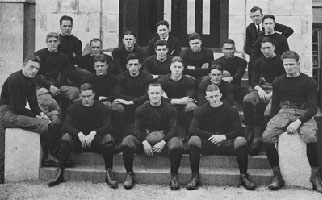 The 1920 team. The 1920 team.
Top Row: James Kennedy; John McClosky; John Heaphy; Coach Frank Cavanaugh; James Doyle; Edward Foy; Frank Morrissey; Philip Corrigan; and Graduate Manager Frank Reynolds.
Middle Row: Thomas Swan; David Mullen; Cornelius O'Brien; George Kelly; James Liston; James Fitzpatrick.
Front Row: Walter Comerford; William Kelleher; Captain Luke Urban; Benjamin Roderick; Herbert Treat.
|
|
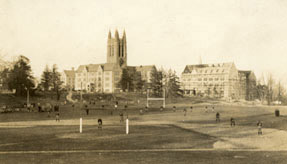 This is a photograph-postcard of Alumni Field in the early 1920s. After the move to Chestnut Hill, games were originally played on a municipally owned field next to the Chestnut Hill Reservoir. Funded primarily with alumni contributions, Alumni Field was dedicated on October 20, 1915 and was used for football, baseball and track. It had a limited seating capacity of only 5000. To accommodate larger crowds, football games were also played in local stadiums such as Fenway Park and Braves Field. This is a photograph-postcard of Alumni Field in the early 1920s. After the move to Chestnut Hill, games were originally played on a municipally owned field next to the Chestnut Hill Reservoir. Funded primarily with alumni contributions, Alumni Field was dedicated on October 20, 1915 and was used for football, baseball and track. It had a limited seating capacity of only 5000. To accommodate larger crowds, football games were also played in local stadiums such as Fenway Park and Braves Field.
|
|
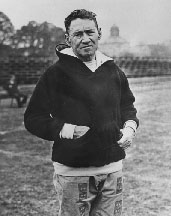 Pictured here is Coach Frank W. Cavanaugh who coached at Boston College from 1919 to 1926. From 1911 to 1916, he had successfully coached Dartmouth College and then served in the United States Army during World War I. Cavanaugh was severely injured by shrapnel and earned the nickname of the "Iron Major." Sports historian Jack Falla characterized his Boston College teams as being "aggressive-some said intimidating-and exceptionally well conditioned." His teams at Boston College had a combined record of 48-14-5. Cavanaugh left Boston College to coach at Fordham University. His teams at Fordham also had a reputation for strong defense and the front line became known as the "seven blocks of granite." He died just prior to the start of the 1938 season. In 1943, he was made the subject of a Hollywood movie, starring Pat O'Brien, called "The Iron Major." Cavanaugh was inducted into the National Football Foundation & College Hall of Fame in 1954 and into the Boston College Hall of Fame in 1970. Pictured here is Coach Frank W. Cavanaugh who coached at Boston College from 1919 to 1926. From 1911 to 1916, he had successfully coached Dartmouth College and then served in the United States Army during World War I. Cavanaugh was severely injured by shrapnel and earned the nickname of the "Iron Major." Sports historian Jack Falla characterized his Boston College teams as being "aggressive-some said intimidating-and exceptionally well conditioned." His teams at Boston College had a combined record of 48-14-5. Cavanaugh left Boston College to coach at Fordham University. His teams at Fordham also had a reputation for strong defense and the front line became known as the "seven blocks of granite." He died just prior to the start of the 1938 season. In 1943, he was made the subject of a Hollywood movie, starring Pat O'Brien, called "The Iron Major." Cavanaugh was inducted into the National Football Foundation & College Hall of Fame in 1954 and into the Boston College Hall of Fame in 1970.
|
|
 Luke Urban (Class of 1921) was the team's captain and a consensus first-team All-American. Though known mainly for playing football, Urban was also active on the baseball, basketball and hockey teams. He is one of only a handful of Boston College athletes to earn varsity letters in four different sports. Coach Cavanaugh characterized Urban as the "most modest man I ever coached" and a psychology professor added that he was the "most unselfish man in the college." Urban played professional football with the Buffalo All-Americans, baseball with the Boston Braves, and he coached football at Canisius College from 1921 to 1930. He returned to his native Fall River, Massachusetts to coach baseball, basketball and football at Durfee High School. He later became the school's Director of Athletics. Urban was inducted into the Boston College Hall of Fame in 1970. He died in 1980 at the age of eighty-three. Luke Urban (Class of 1921) was the team's captain and a consensus first-team All-American. Though known mainly for playing football, Urban was also active on the baseball, basketball and hockey teams. He is one of only a handful of Boston College athletes to earn varsity letters in four different sports. Coach Cavanaugh characterized Urban as the "most modest man I ever coached" and a psychology professor added that he was the "most unselfish man in the college." Urban played professional football with the Buffalo All-Americans, baseball with the Boston Braves, and he coached football at Canisius College from 1921 to 1930. He returned to his native Fall River, Massachusetts to coach baseball, basketball and football at Durfee High School. He later became the school's Director of Athletics. Urban was inducted into the Boston College Hall of Fame in 1970. He died in 1980 at the age of eighty-three.
|
|
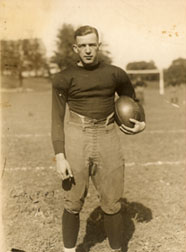 Jimmy "Fitzy" Fitzpatrick (class of 1921) was a speedy half-back with multiple talents. He could pass left or right-handed, had a career punting average of sixty-five yards and possessed a long-range for his drop kick field goals. Fitzpatrick was elected team captain in 1919, but when invited to be captain again in 1920 he modestly refused, allowing his friend Luke Urban to be unanimously chosen. His football career came to an end after his shoulder was broken in the November 1920 game against Georgetown. He was the team's scoring leader in the 1916, 1917, and 1919 seasons. In 1921, Cavanaugh praised him as "the greatest athlete Boston College has ever had...I doubt that any has ever done more for his college in athletics than Fitzy has done for Boston College." Fitzpatrick was inducted into Boston College's Hall of Fame in 1970. Jimmy "Fitzy" Fitzpatrick (class of 1921) was a speedy half-back with multiple talents. He could pass left or right-handed, had a career punting average of sixty-five yards and possessed a long-range for his drop kick field goals. Fitzpatrick was elected team captain in 1919, but when invited to be captain again in 1920 he modestly refused, allowing his friend Luke Urban to be unanimously chosen. His football career came to an end after his shoulder was broken in the November 1920 game against Georgetown. He was the team's scoring leader in the 1916, 1917, and 1919 seasons. In 1921, Cavanaugh praised him as "the greatest athlete Boston College has ever had...I doubt that any has ever done more for his college in athletics than Fitzy has done for Boston College." Fitzpatrick was inducted into Boston College's Hall of Fame in 1970.
|
|
 Boston College proved itself to be a team of national distinction by deafeating the heavily favored squads from Yale University in both 1919 and 1920. In 1919, Boston College won by a score of 5 to 3. Jimmy Fitzpatrick's greatest moment came in the 1919 game against Yale when he drop-kicked a game winning forty-seven yard field goal with only two minutes left to play. For years to come, alumni referred to this play as "the kick." In 1920, they won 21 to 13. This cartoon appeared on the front cover of the October 13, 1920 issue of the Heights (Boston College's student newspaper). The image shows Luke Urban training the Yale Bulldog. Boston College proved itself to be a team of national distinction by deafeating the heavily favored squads from Yale University in both 1919 and 1920. In 1919, Boston College won by a score of 5 to 3. Jimmy Fitzpatrick's greatest moment came in the 1919 game against Yale when he drop-kicked a game winning forty-seven yard field goal with only two minutes left to play. For years to come, alumni referred to this play as "the kick." In 1920, they won 21 to 13. This cartoon appeared on the front cover of the October 13, 1920 issue of the Heights (Boston College's student newspaper). The image shows Luke Urban training the Yale Bulldog.
|
|
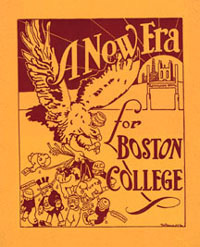 This is the cover of a development brochure produced for the 1921 Boston College Building Campaign. The 1920 Eastern Champions are figured prominently in the brochure indicating the growing importance of Athletics for the university's external visibility and fundraising efforts. The eagle was adopted as the college mascot in early 1920 and quickly became a prominent symbol of Boston College. The 1920 team had the proud distinction to be the first team officially called the "eagles." This is the cover of a development brochure produced for the 1921 Boston College Building Campaign. The 1920 Eastern Champions are figured prominently in the brochure indicating the growing importance of Athletics for the university's external visibility and fundraising efforts. The eagle was adopted as the college mascot in early 1920 and quickly became a prominent symbol of Boston College. The 1920 team had the proud distinction to be the first team officially called the "eagles."
|
Introduction |
1899 |
1920 |
1928 |
1940






